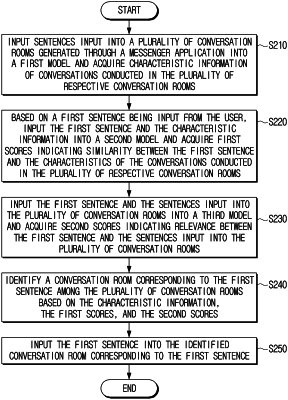| CPC H04L 51/04 (2013.01) [G06F 40/20 (2020.01); G06F 40/30 (2020.01)] | 4 Claims |

|
1. An electronic device comprising:
a memory; and
at least one processor, individually and/or collectively configured to:
input, into a first model, sentences related to a plurality of conversation rooms generated through a messenger application and acquire characteristic information of conversations included in the plurality of respective conversation rooms,
based on a first sentence being an input of a user, input the first sentence and the characteristic information into a second model and acquire first scores indicating a similarity between the first sentence and the characteristics of the conversations included in the plurality of respective conversation rooms,
input the first sentence and the sentences related to the plurality of conversation rooms into a third model and acquire second scores indicating relevance between the sentences related to the plurality of conversation rooms and the first sentence,
identify a conversation room corresponding to the first sentence among the plurality of conversation rooms based on the characteristic information, the first scores, and the second scores, and
input the first sentence into the identified conversation room,
through a formality classification module in the first model, classify the formality levels of the conversations included in the plurality of respective conversation rooms, and acquire third scores indicating a formality of the conversations included in the plurality of respective conversation rooms based on the classified formality levels,
through a topic classification module in the first model, classify the topics of the conversations included in the plurality of respective conversation rooms into a plurality of categories, and acquire fourth scores corresponding to topics of the conversations included in the plurality of respective conversation rooms based on an amount of sentences corresponding to each of the plurality of classified categories in the conversations included in the plurality of respective conversation rooms,
through an activation classification module in the first model, acquire fifth scores indicating degrees of activation of the plurality of respective conversation rooms based on input frequencies of sentences of all users of the plurality of respective conversation rooms, and a frequency of inputting sentences into the plurality of respective conversation rooms,
through the second model, acquire a score corresponding to a formality level of the first sentence and a score corresponding to a topic of the first sentence, calculate first similarity between the acquired score corresponding to the formality level of the first sentence and third scores, and second similarity between the acquired score corresponding to the topic of the first sentence and the fourth scores and, and acquire the first scores corresponding to the plurality of respective conversation rooms based on the calculated first similarity and second similarity,
through the first model, classify the conversations included in the plurality of conversation rooms into a first conversation corresponding to an entire time, a second conversation corresponding to a specified time, and a third conversation including sentences input by the user, and
identify formality levels and topics corresponding to the respective first conversation, second conversation, and third conversation, and acquire the third scores and the fourth scores corresponding to the plurality of respective conversation rooms based on the identified formality levels and topics.
|